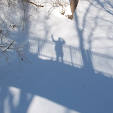In two other posts (
here and
here) we visited sculpture in the grotto area of the Saint Joseph's College campus. Today we visit sculpture on the rest of the campus.

To the east of the chapel there is a large statue of Mary with an interesting history, partially told by two plaques on the base of the statue. The older one reads:
The statue of our Blessed Lady graced the niche in the north tower of the Administration Building from September 1894 until the building was destroyed by fire on the night of February 4, 1973. May she always be the mother of our house, concerned about all we do here.
The newer one states:
Alfred Richard Hentschel September 1, 1916 - February 3, 1988 chose the site and constructed this shrine to Mary the Mother of our house May 1978.

Alfred Hentschel worked for many years in the carpenter shop at SJC and later as director of buildings and grounds. During the Second World War he was a soldier in the German army and was captured by the Russians on the Eastern Front. I recall hearing that many or most of his fellow prisoners died, and he attributed his survival to the intercession of Mary. It was for this reason that he was concerned that the statue be displayed prominently.
In front of Seifert Hall is a stature of Fr. Augustine Seifert, the first president of the college. Seifert Hall was completed in 1939, and the statue was donated by the architect of the building, A.M. Strauss of Fort Wayne.

Sometime in the late 1980s or early 1990s the graduating seniors built a bonfire around the base of the statue and severely damaged it. The damage to the base can still be seen. If you look carefully, you may also see repair work in the neck area.

Located in front of the Chapel on the site of the old Administration Building is a marble statue of St. Joseph and the young Jesus that is named, "Saint Joseph the Educator." It was dedicated on April 15, 1991. (
Contact, Summer 1991). According to a story in the Spring, 1990 issue of
Contact, this statue was a project of the Parents Association.
Daprato Rigali Studios did the design sketches but the actual sculptor was not named. The goal of the Parents Association was to raise $55000 to finance the project. (
Contact is the alumni magazine of Saint Joseph's College.)
I do know know the story of the broken finger, but if I find out, I will update this description.

The plaque at the base of a modernist sculpture near the Core Building parking lot reads:
Amobius, 2000 by Lynn Olson
Created during Mr. Olson's Artist-in-Residency on campus, October 2000. Sponsored by Prairie Arts Council's Community Arts Project II and Saint Joseph's College.
(I have never heard any student refer to this sculpture as Amobius, but I have heard some refer to it as "The Vagina." Students will be students.)

The most recent addition to the statuary on campus is the striking presence of a nun. The notice in the Fall, 2008 issue of Contact, the college's alumni magazine, reported:
A statue memorializing St. Katharine Drexel was dedicated on June 8 at Saint Joseph’s College. The statue is located on the walkway between the Arts and Science Building and the tennis courts. It was commissioned by James ’61 and Esther McMahon. Sculptor Don Wilkins of North Fort Myers, Fla. created the statue with the intention to make it as life-like as possible. Fr. Len Kostka, C.PP.S. ’35 blesses the new statue of St. Katharine Drexel located in the Library Grove.

Sister Katherine Drexel established a
school for Indian boys that lasted only a few years, but the building was key in the establishing the college on its present site. I like the statue, but I do not care for the littering of the area with the benches. Also, the new cement sidewalk replaces an older brick walkway that had a tremendous amount of character. Newer is not always better.

 We may be getting our first real snow of the season. A lot of students will be on the road and it will not be a good day to travel.
We may be getting our first real snow of the season. A lot of students will be on the road and it will not be a good day to travel. This is what we have to look forward to in the next four months.
This is what we have to look forward to in the next four months.

















































